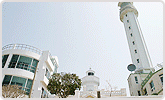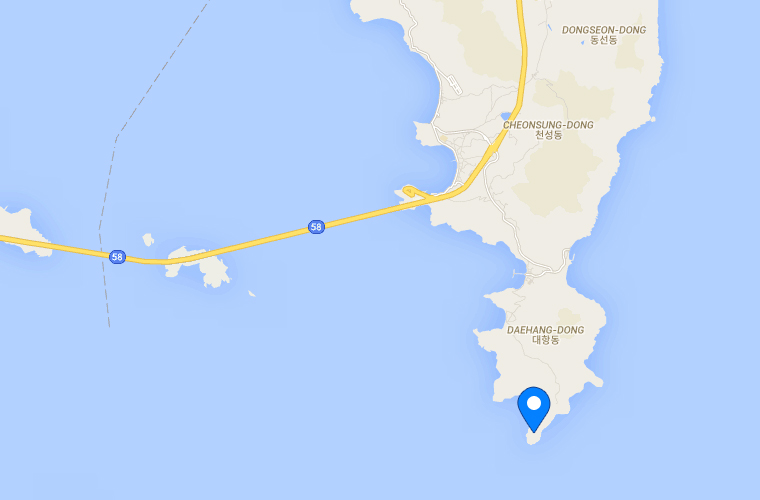Busan Regional Office of Oceans & Fisheries
Aids to
Navigation
Lighthouse
Introduction
 Gadeokdo Lighthouse was placed into operation in December 1909 and situated in a village called Dongdumal at southern end of Gadeok Island. Although the public access to the area is restricted due to its sitting in a military zone, but a tour to the lighthouse can be arranged through an advance reservation. Current structure of the ighthouse has a classical and excellent architectural beauty, and has selected as a preservation site by the Ministry of Maritime Affairs and Fisheries. Gadeokdo Lighthouse is a tangible cultural property #50 of Busan city. Gadeokdo Lighthouse is one of famous fishing site and a large number of anglers visit this location during weekends.
Gadeokdo Lighthouse was placed into operation in December 1909 and situated in a village called Dongdumal at southern end of Gadeok Island. Although the public access to the area is restricted due to its sitting in a military zone, but a tour to the lighthouse can be arranged through an advance reservation. Current structure of the ighthouse has a classical and excellent architectural beauty, and has selected as a preservation site by the Ministry of Maritime Affairs and Fisheries. Gadeokdo Lighthouse is a tangible cultural property #50 of Busan city. Gadeokdo Lighthouse is one of famous fishing site and a large number of anglers visit this location during weekends.
Lighthouse Information
| Location | Gadeok coast to Gangseo-gu, Busan 1237 (daehangdong) (N34 ˚ 59.2 'E128 ˚ 49.9') |
|
|---|---|---|
| The first lighting day | December 1909 | |
| Light Function | Wave cover | Clear and machine: KRB-375 (220V-700W metal to light) Etc. Quality: 12 sec 1 white light flash Island Optical dalgeori: 24M (43 ㎞) |
| Sonic cover | Whistle once every 45 seconds (electric horn) Whistling 5 seconds, 40 seconds jeongmyeong |
|
Tourism attractions
Surrounding natural landscape
 The history of Gadeokdo inhabited since prehistoric times (shell mound, pottery, dolmens) were 39 years of shipbuilding Gadeok jungjong gin gin and nature Manho installed.
The history of Gadeokdo inhabited since prehistoric times (shell mound, pottery, dolmens) were 39 years of shipbuilding Gadeok jungjong gin gin and nature Manho installed.After the sinking of Gimhae flowed bogaesan a legend too.
Natural environment is the main island and 11 uninhabited islands, an area 2096km ², 1.6 times the circumference of 36km Busan zero (23rd national size) soon.
Power law in five living in 1,300 households, and 4,000 people, 459.9m Camellia group of indigenous yeondaebong and intrinsic, and many other relics and scenic spots scattered cheokhwabi and traditional mullet are the best fishing spots in Busan and is famous for its neighborhood.
Noted places near Gadeokdo Lighthouse
 Daewongun
Anti-foreign-Stele
Daewongun
Anti-foreign-Stele - Location: Seongbuk-dong, Gangseo-gu 344(Inside of Cheon-ga Elementary school)
- Appointed Date: February 1st. 1993
It was originally built on 1871 since 1866 by HeungSeon Daewongun and moved to here from the original location which was in Gadeokpo po (Seon chang now)
Size of the tombstone is 1.28m*1.45m*0.16m and the words are written on it.
The words mean "Not fighting when the western savage is invading means amity, and amity means selling the country. I want my progeny acknowledge that."
And it was the decree to the entire nation.
Many tombstones similar this one are built in boarder areas of Korea.
 Monument
to the loyal dead of 23 soldiers
Monument
to the loyal dead of 23 soldiers - Location: Between Cheonseong-dong and Seongbuk-dong in Gangseo-gu
- Built Date: the Memorial Day of 1992
23 spirits, who had devoted their lives for their country as young men of Gadeokdo in the Korean War, are buried in the national army grave yard located in Cheonga-dong. 'Monument to the loyal dead of 23 soldiers' is built to admire the 23 spirits with the monument poem on it.
It is the monument where we can stop by to show the respect and thankfulness for the proud souls of our sons and brothers.
 Chunseongjinseong
Fortress
Chunseongjinseong
Fortress - Location: CheonSeong-dong. 1613, Gangseo-gu.
- Appointed Date: March 10th. 1989
It was the passage where the Japanese invaders used to take since it was located in the key point from Japan to Busan and Jinhae Korea.
It was required to protect this place when the war occurred in 1544 at SaryangJin, so the protective facility for the warships with stone and naval forces stayed there with their base camp.
This place took its role of guardian when our naval forces attacked the Japanese invaders, who were positioned at Angolpo. This place was once destroyed by Japanese invaders but restored by our naval forces.
This castle has a girth of approx. 960m, widths of 4.5m, height of 3.5m, and it shows the traditional construction style of Mid-Josen Empire. It was appointed as monument of Gyeongsangnam-do on December 23rd 1988 and re-appointed as the 34th monument of Busan City on March 10th 1989 as the place was incorporated to Gangseo-gu on Jan 1st 1989.
 Canon Camp of Wae-yang-po
Canon Camp of Wae-yang-po The whole town of Oeyangpo was the place where the Japanese Invader's headquarter for the first time: The Japanese invaders established their headquarter here on May 7th 1905, which was right before the Russian-Japan War on May 27th 1905, and expelled our ancestors who had been living there until then.
Still there are many of their remnants such as battery, barracks, inventory for weapon, observatory, searchlight, power plant, etc. Also the gunpowder that Japanese invaders installed to block the combined forces and the monument of military headquarters is remained to prove the establishment of the base of Japanese invaders.
Location
Address
1237, Gadeokhaean-ro, Gangseo-gu, Busan
Tel : 82-51- 970 - 4061
Busan City Bus Information Management System
http://bus.busan.go.kr
How to get to Gadeokdo LightHouse
By car
-From Gimhae : Gadeok IC→Cheonseong IC→Cheonseong→Daehang→Oeyangpo→Lighthouse
-From Seoul :Daedong IC→Myeongji IC→Cheonseong IC→Cheonseong→Daehang→Oeyangpo→Lighthouse
-From Busan :Eulsuk Main Street→Geogadaegyo Bridge→Cheonseong IC→Cheonseong→Daehang→Oeyangpo→Lighthouse
·Address for the navigation (GPS) : 1237, Gadeokhaean-ro, Gangseo-gu, Busan
*Gadeokdo Lighthouse is located in a military zone. You should make a reservation before a week in advance for the access permit.
(Jinhae Naval Base Command : 82-55-549-4317)
Public Transportation
| Public Transportation | Route | Service Time | Reference |
|---|---|---|---|
| Intra-city bus no. 520 | Busan Station ↔ Cheonseong-dong Gadeokdo | 05:00 ~ 21:00(Every one hour or one hour and ten minutes ) | Taeyeong Passenger :055-547-2508 |

